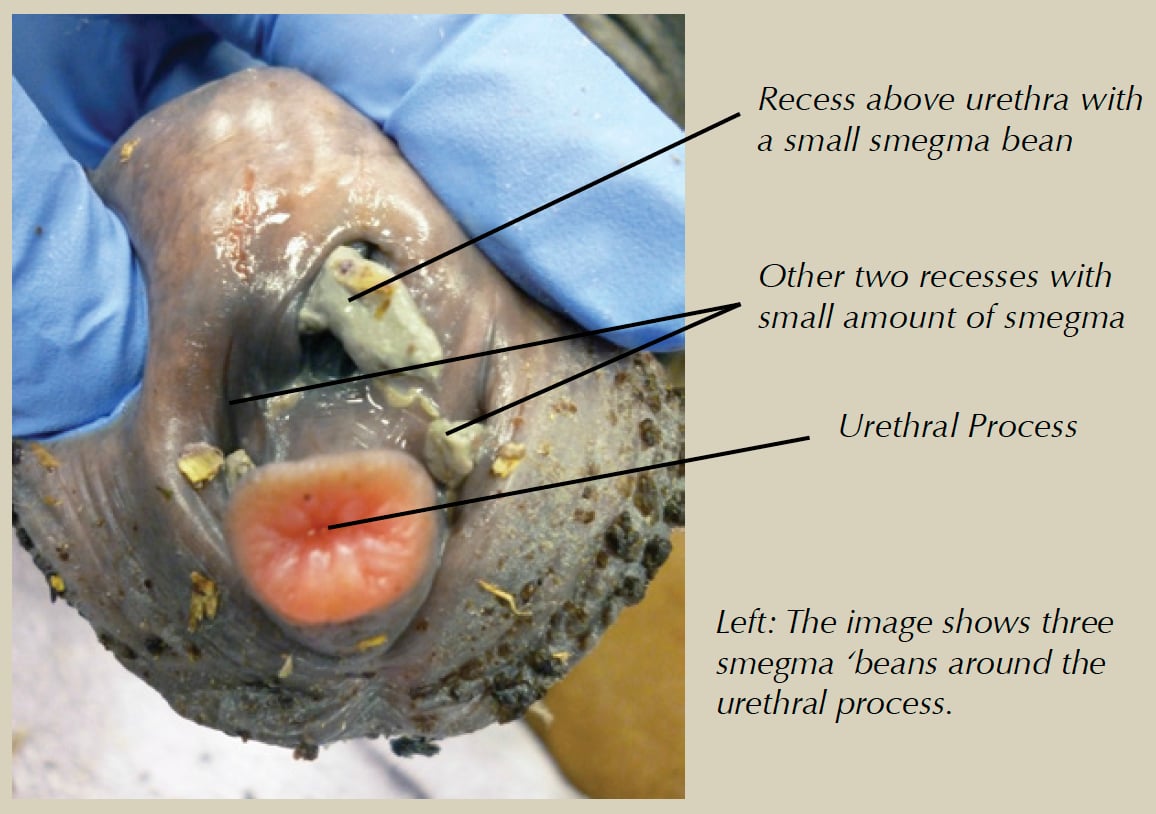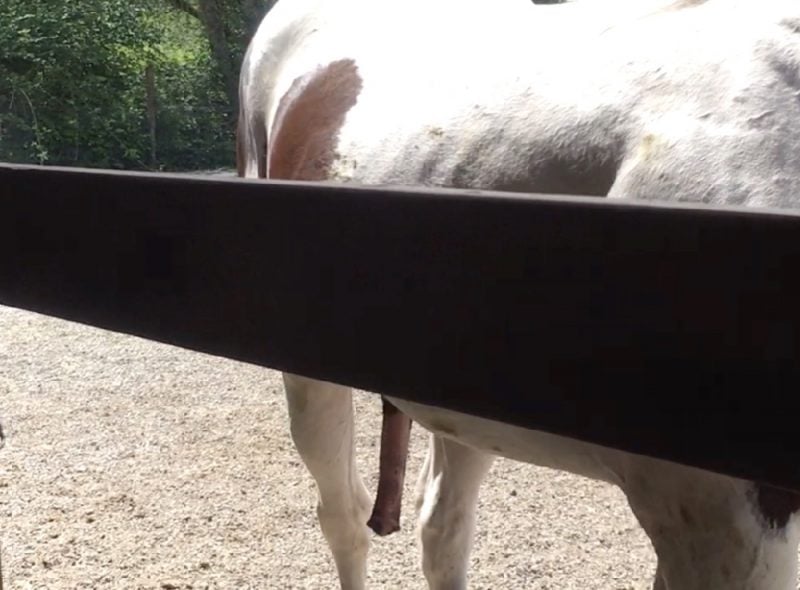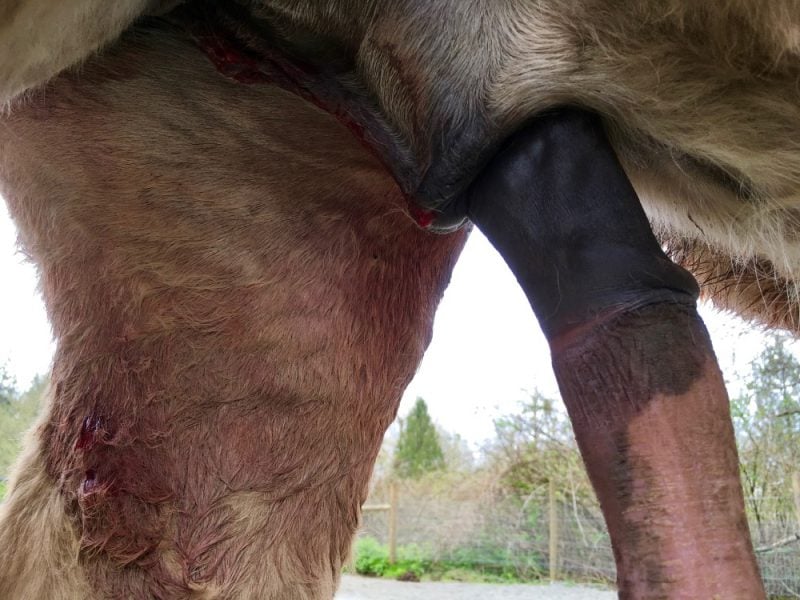My equine chiropractor/bodyworker Ainsley Beauchamp (who has owned 21 geldings) came out to show me a super easy, no-water-needed way to clean my geldings’ sheaths and remove the hardened smegma bean (which can press against the urethra). BUT keep reading, as recent research shows it’s actually better to just leave the sheath alone!
I’m going to take you through that research further down, but for now, let’s take a look at this simplified, less disruptive technique for those times you feel you really must clean your gelding’s sheath.
This video shows a much simpler, faster and more easily-tolerated version of sheath cleaning than the traditional water, soap, cloth/sponge clean. So if you have a young horse, a horse that hates having his sheath cleaned, or a more skittish horse, you may appreciate this technique. Towards the end of the video, Ainsley and I discuss the parameters around doing bodywork on a horse that’s unhaltered, or resistant, and the role the horse owner plays.
The water-based lubricant (shown in the video) allows the horse to “self-clean” as the penis descends and retracts during rest, urination, etc. Or, if your horse wants, you can use water to rinse off the lubricant afterwards. Neither Jax nor Juno wanted theirs rinsed and you can see from the footage 1 week later that leaving the handful of water-based lubricant in the sheath has not created any issues.
Neither of the horses (Jax age 5 and Juno age 3) in this video have had their sheath cleaned before and you can see how Ainsley works with their full permission – unhaltered. However, both horses are well used to having their belly and sheath rubbed, scratched, massaged and they thoroughly enjoy that.
If you have a horse that is skittish around the sheath area, wait until summer when the bugs are biting and then slowly rub your way closer and closer to it. Having an itchy, hard to reach area scratched/rubbed with the right amount of pressure can be extremely enjoyable. Listen to your horse and go at the pace he decrees. Even if it takes you a year or two, you’re better off than bulldozing through his boundaries and then having to use sedation ongoing.
The part that Ainsley makes look easy, but that actually takes a bit of practice, is locating and removing the bean. Here’s an excellent photo showing where the smegma beans can be located that will hopefully make it easier for you – feel free to download the full guide compliments of Horses And People Magazine in Australia that I grabbed this photo from, as it has lots more pictures and info:

What if I never clean the sheath?
On the flip side of the coin: Do we even need to clean our geldings’ sheaths regularly? Who came up with this idea, or the idea that it’s necessary? And if it’s so necessary, how do wild horses survive, breed and urinate without ever having their sheath cleaned? Is this something that only becomes ‘necessary’ once a horse is gelded?
I found this superb article on the subject by Dr. Ben Epsy (DVM) who says, “Contrary to popular belief, cleaning a horse’s penis and the sheath containing it (the prepuce) is rarely necessary. In fact, the aggressive cleaning methods promoted by many well-meaning horsepeople often do more harm than good.” Here’s one of the best bits from Dr. Epsy’s article:
Myth #4: An unusually large smegma “bean” can block a horse’s urethra. Smegma can accumulate in the depression at the end of the penis, called the urethral fossa. Commonly known as the “bean,” this smegma plug can vary from about the size of a small eraser to a lima bean. When male horses stand “camped out”—with their hind legs stretched behind them and their backs hunched in an uncomfortable-looking stance—some people worry that they’re having trouble urinating. But the force of a horse’s urine stream is far too strong to be inhibited by any amount of smegma. In fact, the “camped-out” stance is usually a sign of abdominal pain caused, for example, by ulcers or colic.
Not only is sheath cleaning unnecessary, it can often be harmful. The traditional method of poking a hose up into the sheath and scrubbing it and the penis with sponges and antibacterial soap removes the natural protective covering and healthy bacteria population, potentially causing microabrasions and sores.
Dr. Epsy’s opinion is confirmed by this controlled study carried out on 19 horses by Mariah Beaver et. al at Delaware Valley College in Pennsylvania and presented at the International Equitation Science Conference in Denmark in 2014. The study authors concluded that, “Cleaning a horse’s sheath causes an increase of bacteria, is unnecessary and removes important anti-bacterial proteins from the sheath.”
Interestingly, the study also cites research done by Dr. McDonnell – who maintains a semi-feral herd for the purpose of studying their physiology and behaviour under semi-natural conditions:
“This is supported by observations collected by Dr. Susan McDonnell at the New Bolton Center, University of Pennsylvania. Five stallions coming from the feral herd and castrated from 3-5 years prior to examination and 2 stallions castrated 8 weeks prior to examination were found without bean or malodorous smegma build-up. The geldings have not had any attention to their penis since birth. This concludes that smegma problems may result from human contact with the sheath.”
This is particularly interesting to me, since all four of my feral/semi-feral stallions showed minimal smegma build-up or malodor prior to being castrated. Their penises were quite smooth and lubricated.

Only after castration did I begin to see a build-up (varying in amount from horse to horse) of smegma. And only in Montaro’s case, was the smegma excessive and malodorous.


Cobra (feral mustang) was castrated during a drunken episode at age 7 – so no anti-bacterial substances were used before or after, nor has his sheath been touched before or after. His sheath and penis (age 9 now) look and smell just fine. My other feral mustang, Makah, was castrated at age 3 by the vet. Within 6 months I began to see an increase of smegma on his penis, whereas before it had been fairly clear. My three semi-feral horses (Jax, Juno and Montaro) were all castrated by a vet. Jax and Juno did now show much smegma before the cleaning shown in this video. As I mentioned, only Montaro had excessive smegma and a malodorous smell.
I wonder if the bacterial balance of the sheath is negatively affected by the antibacterial fluids (to sterilize the area) applied prior to the castration surgery? In Montaro’s case, he also received oral antibiotics 6 months later due to a heel injury/surgery. Although I followed these with oral probiotics, the pre-existing bacterial imbalance, combined with his anger at being castrated (emotional contributor to dis-ease), could have resulted in an overgrowth of undesirable bacteria. Interestingly, Montaro’s half-sister Audelina also has malodorous moist smegma between her teats – which I treat sporadically with a wild oregano/zinc oxide paste.
In Dr. Beaver’s study, the horses were divided into 3 groups cleaned with water, Excalibur and baby shampoo. The group cleaned with just water had the least increase in bacterial growth; and the group cleaned with Excalibur (which contains tea tree oil, SLS and other undisclosed ingredients) had the greatest increase.
So if you must clean your horse’s sheath, then just use water, or a water-based lubricant like the one we used in this video (make sure the lubricant doesn’t contain any antibacterial substances). 1 drop of Lavender oil is unlikely to do much harm, but feel free to skip that as well. I also suspect that the missing piece here is not just to say, “Don’t clean the sheath.” But rather, to replace the missing bacteria with good bacteria, then sheath cleaning is no longer necessary. If you have a horse that continuously produces off-smelling smegma and massive amounts of it, or large beans that produce visible relief when removed, it’s not going to be helpful, or change the outcome, to just stop cleaning the sheath. However, in light of this research, giving the sheath a good clean and then liberally coating with probiotic gel seems likely to produce a positive outcome. The question is how often would you need to apply the probiotics and how much probiotic gel do you need to use?
I have thoroughly cleaned Montaro’s sheath four times now since his gelding 3 years ago. I have used various natural anti-pathogen agents and then applied Equiflora probiotic gel to the sheath once. In light of this research, if I feel led to do anything more, I will limit my intervention to only applying probiotics to his sheath and I will also increase his intake of oral probiotics.
However, after Montaro’s last craniosacral session with Ainsley a few months ago, his sheath area has smelled okay and the smegma is no longer oozing out in great big clumps. During the session, Ainsley was hit with a wall of grief from his body, and she energetically supported him as he processed it. She also worked with his heart and liver. So perhaps this was the final piece of the emotional healing around his castration (he really wanted to remain a stallion) and has resulted in the marked physical change in the sheath area.
Remember, the mind/body/spirit are ONE, so with any chronic health issue, we need to address the emotional/spiritual aspects as well.

Jini Patel Thompson is a natural health writer and Lazer Tapping instructor. She began riding at age 2 in Kenya, and got her first horse at age 8 in Alberta, and so continues a life-long journey and love affair with these amazing creatures.








The reason wild horses/stallions don’t need their sheath cleaned is due to them constantly mounting and mating in the wild. As you know…once we capture, castrate and put horses in an unnatural environment they no longer mount and mate naturally so the sheath becomes dirty. Just as hooves don’t need trimming in the wild, once in an unnatural environment they must be trimmed, in most cases. I have read many articles on the subject and fresh water a few times a year won’t destroy good bacteria.
Except that most stallions never get to breed and live in bachelor herds – so there goes that theory. I love that Dr. Beaver actually did a controlled study to test our perceptions of whether water or cleansers etc have a positive or negative effect. It would be very good for vets to do more! More data would certainly be helpful. Your boy is gorgeous – thanks for uploading a pic!
Excellent piece.
A lady friend once quipped that, between menstruation and menopause, all her worst times started with “men.”
I think much the same could be said for horses.
Most of their problems seem to stem from “MANagement.”
I can’t help but wonder about a connection between sheath-cleaning and male circumcision.
I’ve heard people give that as a reason for skinning their child’s penis – that they’re worried (or someone told them) the covering of skin will get “dirty” and prone to infection. Ludicrous.
This one is another subject / topic very close to me! Bullet is a gigantic sheath cleaning monger! When we came together 7 1/2 years ago & he had come from an undesirable situation! I was also still very green and had only been horsing around for a couple of years! One day when the horses were chilaxing and I was out with them giving rubs and scratches Bullet directed me towards his sheath? He dropped and I could see at the very top under a bit of a last fold a flat small egg shaped chunk of black hardness! I very gently and fearfully grabbed it …it was such a big chunk to be shoved up there! I could tell he got a lot of relief from it being removed & I could also tell he was so ok with me poking around…so I continued! I found two more ugly big chunks and that was the beginning of his obsession with me working with his sheath! Although it did not progress quickly and it is now so many years later we have had a big learning curve in all things sheath! I have used home made concoctions…and professional brand name cleaners and I think our dry approach is actually the least harmful and disruptive to his sheath area! The last couple of years he has really become obsessed with having me pick his sheath! It’s all he says to me when we are around each other! I actually have to be quite strong in my energy and tell him no! I’m not doing that right now! I had really hoped when I cleaned up there nutrition after Dreamers founder that it would help the situation but it is still his obsession! And his sheath is still not ideal! I have cleaned the bean out but he produces the most smegma I have ever seen on a horse and his sheath is always horribly gunky! It at least doesn’t have the strong smell as mush anymore so I am hoping that’s a positive! I so feel for him as I can feel his frustration with how itchy it is! But I also have come to realize that my intervention along the way has probably contributed to his upset of the flora! I try to keep the smegma picking to a small roar and just do it dry! Yes my hands get nasty but he is worth it! I make sure not to be rough and make a sore! Although he could care less and just wants me to never stop!
Dreamer on the other hand was a don’t touch any where around that area kind of guy for the first two years we were together! If I tried to scratch anywhere around there I would get a angry tail swish then …a lift of the leg …if I tried again! But one time when he dropped I bravely and quickly felt he had a huge bean…although his penis is mostly very clean and super large…not that …that matters …but dang …his really is ultra big! Anyway he would not let me get it…so I did have the vet come and sedate him and this is the bean that came out! The next few days you could tell he was like a new man! He seemed to get a lot of relief from it being removed…so I was glad I actually went against my mostly “ no vet beliefs mantra” and just had it done! Banner and Buck are somewhere in between and will let get a small bean and I remove any loose or funky chunks that I see when they drop…but there is not much and they stay relatively clean and I don’t feel it’s an issue for them!
I think when we geld male horses it does completely disrupt the way Mother Nature intended them to be ….so …human intervention…..just ends up needing more human intervention! I also think Gelding a horse is practical because there are already so many unwanted horses in the world being slaughtered! It’s not fair to keep them all as stallions and isolate them from the herd! Although I can completely understand the trauma each of these choices represent to them!
One more thing…Jini…you said something I have never heard you say? Aude is Montaro half sister? And I know also the mother of his offspring…Juno? I did not know this? Do you feel or sense any negative affects of the inbreeding? Or do I have this completely wrong ?
✌🏼❤️🐴
Here’s the bean Michelle talked about
Yep you heard right – Aude, Montaro and Jax all have the same Belgian father. Montaro went through a solid wood fence with a line of hotwire across the top to breed Aude the night before his castration. I too was concerned about inbreeding, until I learned that this is far from uncommon in the horse world and is called “line breeding”! While I still think it is far from ideal, I was relieved I wouldn’t have to worry about mental or physical disability.
I wonder what would happen with Bullet if you applied a dose of Equiflora to his penis/sheath every time he asked you for itches – there are 10 doses per syringe. That would be interesting – especially since you’ve already tried everything else! Or looking to the emotional/spiritual plane and booking an EFT Tapping or similar mind/body therapy session for him.
I’m living with new horses at our new home , the owner also lives on the land , she tends to hands off about most things, to the point of being in-attentive,, ( i.e., when we moved here December/18 her 28 yr old mare with few remaining teeth, very obviously Cushing-oid and not treated, severely underweight by about 200lbs, not being fed age-appropriate soaked feed ,,and so severely arthritic that she was laying down 20 hours a day. I managed to feed her up with soaked feed , rugged her, she gained weight amzngly even thru the winter, with barely any shelter. she was euthanized in March.) the land-owner’s 20 yr old non-ridden gelding has extreme spinal hyper-extension since he was very young she says,, his feet are not trimmed regularly, and he is in very obvious discomfort,,, all this to say that in April this year I noticed him straining to urinate, very little stream being emitted. I asked him if he needed his sheath and penis cared for,, he was soo grateful he almost jumped into my arms. I removed 4 beans the size of the end of my thumb, and massaged his sheath and belly and legs till my arms gave out, all the while he was totally blissing out. then he had a lovely, long, pee. Since then he is always asking me to massage his sheath and under carriage,, i do check for beans often , no more have formed. his owner said his sheath has never been checked before. I feel a profound sense of longing for love, for attention, from the owner’s 2 remaining horses, and from the un-cared for land we live on ( frank and i are not welcomed to physically ‘attend’ to the land), and from the trees, plants, earth. I know my physical /energetic presence here is an “energy trans-former” on many levels.. in the past I have just checked the geldings for beans or swollen sheaths , and intervened if i ‘felt’ they needed . My own many mares over the years, and mares boarding with me, ,, all have loved their udders massaged and cleaned, so I’ve obliged them when they ask. so I’ll continue to give attention to horses here as they ask me, , which they all ways do.., *** Also,, the well water here is very ‘hard’**,, do you think it would it exacerbate penile beans? I wonder the effects of hard water on the horses and us? my guts sure don’t feel good here, and Girl has taken a noteable downturn in mobility a month ago, her lower legs are swollen most of the time now. blood/urine tests in nov/17 showed High B.U.N. – renal disease indicator .. rambling a bit,, and thanks,, for your amzing insights and encouragement,, so generously given here by you and everyone xoxoxoxo
That is so interesting Sheila! I wonder what you’d discover if you had the water there tested…
And again, I think we could gather tons of stories to support the idea that if you just leave the sheath/penis alone after castration (my working theory is that the surgery negatively alters the bacterial flora in the region), the horse is unlikely able to do well after a few years, or in some cases, within a year.
But, if we give therapeutic-grade probiotics, both orally and regionally following castration, until a good bacterial flora is restored, I wonder if that will then allow the gelded horse to manage well without further cleaning?
I have just ordered 15 syringes of Equiflora so I’ll begin applying those to the sheath area of the 3 geldings who will allow it, but all 5 geldings will receive probiotics orally with their alfalfa pellets and vitamins. And I will see what happens over the next few years!
Thanks for this! Dakota has been trying to find a place to scratch his itch for months…a few weeks ago I noticed flies going around his groin area. His penis has looked more caked in the last year or more…. Today I noticed that when I scratched him near the area, he started making funny faces 🙂 He really liked it. My first mistake was to dig in with my bare hands. It just happened, and I realized, wow, it’s just really nasty in here. Well, the smell. I could not get it out of my hands later! I did use water and a small sponge, and kept rinsing it out.
I came back inside, watched this video and read the blog (which I had already, a long time ago) and used aloe vera and some rose hip oil as I had nothing else on hand, and got back out and applied it with gloves. Mostly I got out tiny pieces and dirt. I’ll see how he does in the next few days. He’s showing no trouble peeing, but he’s going for the bushes all the time to scratch, so I hope what I did helped! Thanks!
Aloe vera sounds perfect! He may ask you to do some more if he needs it – you’ll know 🙂
This was a wonderfully valuable video! I’m fostering an 18 year old gelding right now. This video helped me carefully and as close to naturally (not a bunch of chemicals) get out a HUGE bean (3.5 cm). I’m certain he has got to feel better. Plus saving me so much money in Veterinarian bills. I’m very happy how well the lube/lavender softened everything up as well as cleaning it all up. Thank you a thousand time from both of us.
Oh how wonderful! You make my heart happy. And you’re both very welcome 🙂
Thank you for sharing this knowledge! Outstanding information. I agree with all your observations.
You’re welcome Magdalena!
I am a professional groom with decades of experience. Sheathe cleaning is absolutely necessary. Too many horse owners believe tail rubbing is a result of parasites, when the horse is trying to scratch the incredible discomfort of a dirty sheathe or udder.
Second, please omit the essential oil. Essential oils are only to be used highly diluted, and can burn the skin or even cause allergic and toxic reactions. There is NO reason to use it for a sheathe clean.
Yes, you’re correct on the usage of essential oils – however she has diluted it sufficiently in the gel before application. And good tip on the tail rubbing – check the sheath/udder! Thanks.